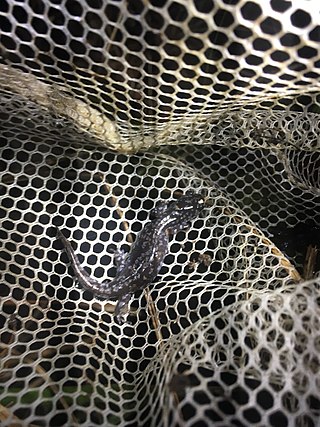
The tiger salamander is a species of mole salamander and one of the largest terrestrial salamanders in North America.

The spotted salamander or yellow-spotted salamander is a mole salamander common in eastern United States and Canada. It is the state amphibian of Ohio and South Carolina. The species ranges from Nova Scotia, to Lake Superior, to southern Georgia and Texas. Its embryos have been found to have symbiotic algae living in and around them, the only known example of vertebrate cells hosting an endosymbiont microbe.

The California tiger salamander is a vulnerable amphibian native to California. It is a mole salamander. Previously considered to be a subspecies of the tiger salamander, the California tiger salamander was recently designated a separate species again. The California tiger salamander distinct population segment (DPS) in Sonoma County and the Santa Barbara County DPS are listed as federally endangered, while the Central California DPS is listed as federally threatened. The Sonoma County, south San Joaquin, and the Santa Barbara County DPS have diverged from the rest of the California tiger salamander populations for over one million years, since the Pleistocene and they may warrant status as separate species.

The Jefferson salamander is a mole salamander native to the northeastern United States, southern and central Ontario, and southwestern Quebec. It was named after Jefferson College in Pennsylvania.

The blue-spotted salamander is a mole salamander native to the Great Lakes states and northeastern United States, and parts of Ontario and Quebec in Canada. Their range is known to extend to James Bay to the north, and southeastern Manitoba to the west.

The frosted flatwoods salamander is an endangered salamander species native to the Southeastern United States.

Mabee's salamander is a species of mole salamander found in tupelo and cypress bottoms in pinewoods, open fields, and lowland deciduous forests, pine savannahs, low wet woods, and swamps. It usually burrows near breeding ponds. Eggs are attached to submerged plant material or bottom debris of acidic, fishless ponds in or near pine stands. In Virginia, it breeds in fish-free vernal pond in a large clear-cut area and in ephemeral sinkhole ponds up to 1.5 m deep, within bottomland hardwood forest mixed with pine. Larvae develop in the ponds. Distances moved into terrestrial habitat are unknown, but probably are greater than 150 metres (490 ft).

Anderson's salamander is a neotenic salamander from Zacapu Lagoon in the Mexican state of Michoacán.

The Lake Patzcuaro salamander, locally known as achoque is a neotenic salamander species.
The blunt-headed salamander is a mole salamander endemic to Mexico. It is only known from the vicinity of its type locality, near Morelia, in Michoacán state in Southwestern Mexico. It inhabits a landscape consisting of a mosaic of natural grasslands and pine-oak forests at elevations of about 2,000 m (6,600 ft) asl. Breeding takes place in ponds.
The Puerto Hondo stream salamander or Michoacan stream salamander is a mole salamander from the Trans-Mexican Volcanic Belt within the Mexican state of Michoacán.

The small-mouth salamander is a species of mole salamander found in the central United States, from the Great Lakes region in Michigan to Nebraska, south to Texas, and east to Tennessee, with a population in Canada, in Pelee, Ontario. It is sometimes referred to as the Texas salamander, porphyry salamander, or the narrow-mouthed salamander. The Kelley's Island salamander was synonymized with A. texanum in 1995.

Ambystoma talpoideum, the mole salamander, is a species of salamander found in much of the eastern and central United States, from Florida to Texas, north to Illinois, east to Kentucky, with isolated populations in Virginia and Indiana. Older sources often refer to this species as the tadpole salamander because some individuals remain in a neotenic state. This salamander lives among the leaf litter on the forest floor, migrating to ponds to breed.

The Tarahumara salamander is a freshwater species of mole salamander in the family Ambystomatidae, endemic to Mexico. Its natural habitats are temperate forest, subtropical or tropical moist montane forest, subtropical or tropical high-altitude grassland, rivers, freshwater marshes, pastureland, and ponds.
The reticulated flatwoods salamander is a species of mole salamander, an amphibian in the family Ambystomatidae. The species is native to a small portion of the southeastern coastal plain of the United States in the western panhandle of Florida and extreme southwestern Georgia. The species once occurred in portions of southern Alabama but is now considered extirpated there. Its ecology and life history are nearly identical to its sister species, the frosted flatwoods salamander. A. bishopi inhabits seasonally wet pine flatwoods and pine savannas west of the Apalachicola River-Flint River system. The fire ecology of longleaf pine savannas is well-known, but there is less information on natural fire frequencies of wetland habitats in this region. Like the frosted flatwoods salamander, the reticulated flatwoods salamander breeds in ephemeral wetlands with extensive emergent vegetation, probably maintained by summer fires. Wetlands overgrown with woody shrubs are less likely to support breeding populations.
The mountain stream salamander or mountain stream siredon is a species of mole salamander that only lives in central México.












